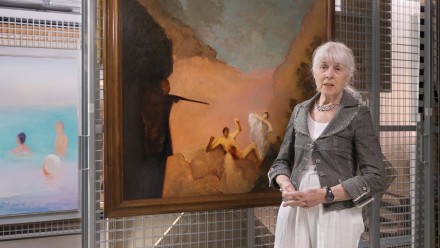Image

SCHIEDAM — Constant regularly captured the horrors of war in his paintings, a world that still exists, despite international peace missions and consultations.
Read the article in Dutch on schiedam24.nl
Under the title “Constant in oorlog”, the Stedelijk Museum Schiedam made four short films, about for works by Constant from the collection with war as a theme. More than ten people, including a journalist, army veteran and spoken word artist, talk about why the work touches them and how they recognize their own life in the painting. Some participants experienced war and violence themselves and fled to the Netherlands. “We bring Constant’s work to a new generation of viewers,” says museum director Anne de Haij. The films can be viewed on the museum’s website and on YouTube. Constant painted the works between 1951 and 1999.
In one of the films, Trudy Nieuwenhuys, Constant’s wife, also speaks. She says, “Constant has been a rebel all his life, an activist.” “This is what you still see on the news,” says the Frisian Hannah from 5 VWO about the painting Les expulsés (The expelled). The artist painted it 22 years ago. “You would think it would be better now (…) but it still happens,” adds her friend and classmate Sijda. Schiedammer, historian and journalist Suëda Işık sees more than misery. “The work is hopeful because you see people resisting together.”
The films that Gerrit Schreurs made form a four-part series and can also be viewed separately. Each painting recalls a bloody historical event. L’insurrection (The Uprising, 1985) refers to the Paris Commune, a revolutionary government that ruled Paris for over two months until it was brutally crushed at the end of May 1871. Les expulsés (The Expelled, 1999) painted Constant in 1999 during the Kosovo war. He was inspired by the cover of Time Magazine with a long line of refugees.





L’exécution (The execution, 1982) arose in response to the murder in El Salvador of four Dutch IKON journalists in 1982. They made a report about the violent civil war and were met and shot dead by soldiers of the government army. For the painting Terre brûlée (Scorched Earth (III) (1951)), Constant may have been inspired by the Korean War in 1950. He took the title from the tactics of Soviet troops on the Eastern Front.The work is primarily a warning of the horror of wars.
The participants were shown ‘their’ painting prior to the interview. That way they could think about it beforehand. Some were literally inspired by the work and/or the themes. For others, the relationship with the work of art is less clear. They were inspired by the theme of Constant.
Artwork and participants:
— Les expulsés (The Outcasts): Hannah and Sijda (5 VWO students), Antonis Pittas (artist, teacher, curator exhibition Constant 101: The Future Can be Humane in the Cobra Museum), Peter Blanker (poet, songwriter, singer)
— L’insurrection (The Revolt): Parham Rahimzadeh (debuted this year with the novel Arab, grew up in Schiedam), Carlien Lammers (junior curator of modern and contemporary art Stedelijk Museum Schiedam), Süeda Işik (historian, journalist, Schiedammer), Juan Heinshohn Huala (poet, artist, refugee from Chile, organizer of cultural events)
— Terre brûlée (scorched earth): Esther Cappon (army veteran, photographer), Wim Post (son of war victim, socially involved Schiedammer), Lana Mesić (photographer, she experienced the war in Croatia as a child)
— L’exécution (The execution): Trudy van der Horst (wife Constant, art historian), Jacco van Giessen (journalist RTV Rijnmond), Nabil Tkhidousset (spoken word artist, teacher, Schiedammer)
The series is part of the commemoration year of the Fondation Constant. This year the foundation celebrates that Constant Nieuwenhuijs (1920-2005) was born 101 years ago. One of the works — Les expulsés (The Expelled) — is on display at the Cobra Museum from November 5 to March 27, 2022 in the exhibition Constant 1 0 1: The Future Can be Humane. The Stedelijk Museum Schiedam is closed until spring due to a municipal renovation of the building.
The video quadruple was made by Gerrit Schreurs, who previously made films about other artists. Each film ends with a call to viewers to make something themselves. This can be a poem or drawing or something else that you can send to the museum by email: E: Stories@stedelijkmuseumschiedam.nl. A selection of these can be seen on the museum’s website and via social media.
The Stedelijk Museum Schiedam has an extensive Cobra collection, in which the oeuvre of Constant, initiator and intellectual brain behind the Dutch Cobra branch, occupies an important place. Since 2008, the museum has also managed a large number of works from the estate that the Foundation Constant has transferred to the museum on long-term loan. That work comes directly from the Amsterdam studio, where Constant worked from 1964 and which was then vacated with the help of the Stedelijk Museum Schiedam.
Constant is best known for his Cobra work and the New Babylon project in the 1960s. In the period from 1971 until his death he returned to painting. In these works he shows a great commitment to the world. This late work provides a complete overview of Constant’s later work, which is not yet available in any museum. The paintings are therefore of great importance to both the Stedelijk Museum Schiedam and the Netherlands Collection.
Thanks to: Municipality of Schiedam, Fondation Constant, SodaFabriek, S’DAM.